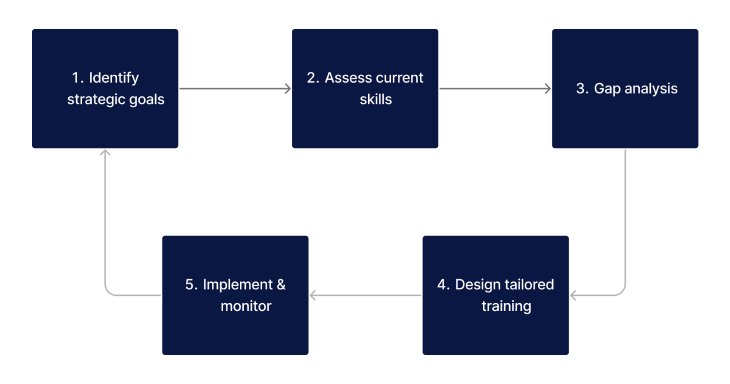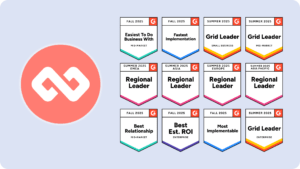Have you ever wondered how organizations effectively train their employees to achieve their goals? Training roadmaps are the secret sauce that drives efficient and targeted learning initiatives. In this comprehensive guide, we will demystify training roadmaps, explore their various types, and unlock the multitude of benefits they offer for both employees and organizations. So, buckle up and get ready to embark on a transformative journey of learning and growth!

Demystifying Training Roadmaps
Understanding the Components of a Training Roadmap
A training roadmap is a strategic plan that outlines the learning path an individual or team needs to follow to acquire the necessary skills and knowledge. These roadmaps typically consist of several essential components that work together to ensure a holistic learning experience. Let’s dive deeper into these components:
- Goals and Objectives: Clearly defined goals and objectives lay the foundation of a training roadmap. They outline what skills and competencies need to be developed and provide a roadmap’s direction.
- Competency Framework: A competency framework is a structured approach to describe the specific skills and behaviors required to perform a job successfully. It helps identify skill gaps and enables targeted training interventions.
- Learning Resources: From e-learning modules and webinars to workshops and coaching sessions, an effective training roadmap offers a variety of learning resources tailored to individual needs.
But there’s more to training roadmaps than just these components. Let’s explore some additional aspects that contribute to their effectiveness:
Assessment and Evaluation: Before embarking on a training journey, it’s crucial to assess the current skill levels of individuals or teams. This assessment helps identify existing strengths and weaknesses, allowing for personalized training plans. Regular evaluation throughout the learning process ensures that progress is being made and adjustments can be made if necessary.
Collaborative Learning Opportunities: Training roadmaps can be enhanced by incorporating collaborative learning opportunities. Group projects, team-based exercises, and peer-to-peer learning can foster a sense of camaraderie and encourage knowledge sharing. Collaborative learning also promotes problem-solving skills and the ability to work effectively in a team.
The Impact of Goal Alignment in Training Roadmaps
Aligning training goals with organizational objectives is crucial for achieving success. When learning initiatives are directly linked to overarching business goals, employees gain clarity on why certain skills are crucial and how they contribute to the bigger picture. Moreover, goal alignment enhances employee motivation, engagement, and commitment to their own development.
Steps to Align Training Programs with Organisational Goals:

Crafting Effective Learning Pathways
Creating a well-structured learning pathway is a key aspect of designing effective training roadmaps. A learning pathway provides a step-by-step progression of skills acquisition, guiding employees through their development journey. By breaking down complex skills into smaller, manageable learning modules, organizations can ensure a smooth and engaging learning experience.
Optimizing Resource Allocation for Training Success
While designing training roadmaps, it is essential to allocate resources wisely to maximize the impact of learning initiatives. Proper resource allocation ensures that employees have access to the right training tools, technologies, and support mechanisms required for successful skills development. It’s like equipping them with a toolbox of knowledge and skills to excel in their roles.
Sequencing Training Activities for Maximum Impact
Sequencing training activities strategically plays a vital role in achieving optimal learning outcomes. A well-structured training roadmap should prioritize foundational skills before diving into more advanced topics. This logical progression allows employees to build a strong knowledge base and gradually expand their expertise, setting them up for success.
Incentivizing Learning with Rewards
Have you ever found yourself more motivated to learn when there’s a reward waiting at the finish line? Incentivizing learning through rewards can be a powerful strategy to drive employee engagement and motivation. Whether it’s recognition, career advancement opportunities, or tangible rewards, a little extra motivation can go a long way in unlocking employees’ full learning potential.
Adapting Training Roadmaps to Changing Needs
In today’s rapidly evolving business landscape, organizations must embrace agility and adaptability. Training roadmaps should not be static documents but rather living frameworks that can flex and evolve with changing needs. By regularly assessing and updating training roadmaps, organizations can ensure that learning initiatives are aligned with the latest industry trends and emerging skills.
Unlocking the Benefits of Training Roadmaps
Boosting Employee Performance Through Training
Training roadmaps are powerful tools for enhancing employee performance. By providing employees with clear learning paths, organizations empower them to acquire new skills, improve their performance, and contribute to the overall success of the organization. When employees feel supported and equipped to excel in their roles, productivity soars to new heights.
Driving Productivity Gains with Training Roadmaps
Productivity is the lifeblood of any successful organization. Training roadmaps play a crucial role in driving productivity gains by equipping employees with the right skills and knowledge to perform their tasks efficiently. By identifying skill gaps and addressing them through targeted training, organizations can turbocharge their workforce’s productivity and achieve sustainable growth.
Enhancing Job Satisfaction Through Training Initiatives
Training initiatives that prioritize employees’ personal and professional growth can significantly impact job satisfaction. When organizations invest in their employees’ development through well-designed training roadmaps, it sends a powerful message that the organization values their growth and success. This commitment to learning creates a positive work environment and fosters a sense of loyalty and satisfaction among employees.
Fostering Long-Term Organizational Growth
A robust training roadmap sets the stage for long-term organizational growth. By consistently upskilling employees and strategically aligning training initiatives with business goals, organizations ensure a continuous influx of talent equipped with the skills needed to drive innovation and adaptation. This ongoing investment in the workforce creates a strong foundation for sustained success and future growth.
Maximizing Training Outcomes with Roadmaps
Training initiatives without a roadmap can be like embarking on a journey without a destination in mind. Training roadmaps provide structure and focus, ensuring that every step taken leads to meaningful learning outcomes. By outlining clear objectives, sequenced activities, and available resources, training roadmaps maximize the return on investment organizations make in their learning and development programs.
Moreover, training roadmaps also foster a culture of continuous learning within organizations. When employees have a clear roadmap for their professional development, they are more likely to actively seek out opportunities for growth and improvement. This self-driven approach to learning not only benefits the individual employees but also contributes to the overall knowledge and expertise within the organization.
Additionally, training roadmaps can also help organizations identify emerging trends and technologies in their industry. By staying ahead of the curve and incorporating relevant training programs into their roadmaps, organizations can ensure that their workforce remains up-to-date with the latest advancements. This proactive approach to training not only enhances employee performance but also positions the organization as a leader in the industry.
Exploring Different Types of Training Roadmaps
Navigating Linear Training Roadmaps
Linear training roadmaps are perhaps the most straightforward type of roadmap. They follow a sequential structure, where employees progress through a set curriculum in a linear fashion. The advantage of linear roadmaps is their simplicity and ease of implementation. However, it’s important to ensure that linear roadmaps still allow for flexibility and individual adaptation to accommodate diverse learning styles and needs.
Linear training roadmaps can be particularly beneficial for new hires or individuals looking to build foundational knowledge in a specific area. By providing a clear path of progression, employees can easily track their development and understand the logical sequence of learning activities.
As we wrap up this ultimate guide to training roadmaps, we hope you now have a deeper understanding of their definition, the various types available, and the immense benefits they offer. Whether you’re an individual looking to enhance your skills or an organization seeking to optimize learning initiatives, training roadmaps can be your compass towards continuous growth and success. So, why wait? Start charting your learning journey today and unlock your full potential!
Ready to elevate your organization’s training and mentoring programs? Discover how Mentorloop can streamline your journey to success. Our platform is designed to assist HR and L&D Leaders, Functional Leaders, Community Managers, and Professionals in various fields, including Charities and Nonprofits through our Community Support Program. Experience the power of effective mentoring with Mentorloop and see firsthand how it can enhance your training roadmap. Book a Demo today and take the first step towards running your best mentoring program yet.




